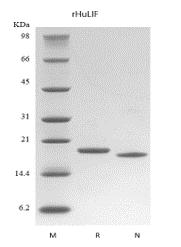- Synonyms
- Differentiation-stimulating Factor, D Factor, Melanoma-derived LPL Inhibitor, MLPLI
- Source
- Escherichia coli.
- Molecular Weight
- Approximately 19.7 kDa, a single non-glycosylated polypeptide chain containing 180 amino acids.
- AA Sequence
- SPLPITPVNA TCAIRHPCHN NLMNQIRSQL AQLNGSANAL FILYYTAQGE PFPNNLDKLC GPNVTDFPPF HANGTEKAKL VELYRIVVYL GTSLGNITRD QKILNPSALS LHSKLNATAD ILRGLLSNVL CRLCSKYHVG HVDVTYGPDT SGKDVFQKKK LGCQLLGKYK QIIAVLAQAF
- Purity
- > 98 % by SDS-PAGE and HPLC analyses.
- Biological Activity
- Fully biologically active when compared to standard. The ED50 as determined by the dose-dependent proliferation of human TF-1 cells is less than 0.1 ng/ml, corresponding to a specific activity of > 1.0 × 107 IU/mg.
- Physical Appearance
- Sterile Filtered White lyophilized (freeze-dried) powder.
- Formulation
- Lyophilized from a 0.2 μm filtered concentrated solution in PBS, pH 7.4.
- Endotoxin
- Less than 1 EU/μg of rHuLIF as determined by LAL method.
- Reconstitution
- We recommend that this vial be briefly centrifuged prior to opening to bring the contents to the bottom. Reconstitute in sterile distilled water or aqueous buffer containing 0.1 % BSA to a concentration of 0.1-0.2 mg/mL. Stock solutions should be apportioned into working aliquots and stored at ≤ -20 °C. Further dilutions should be made in appropriate buffered solutions.
- Stability & Storage
- Use a manual defrost freezer and avoid repeated freeze-thaw cycles.
- 12 months from date of receipt, -20 to -70 °C as supplied.
- 1 month, 2 to 8 °C under sterile conditions after reconstitution.
- 3 months, -20 to -70 °C under sterile conditions after reconstitution.
- Usage
- This material is offered by Shanghai PrimeGene Bio-Tech for research, laboratory or further evaluation purposes. NOT FOR HUMAN USE.
- SDS-PAGE

- Reference
- 1. Eswari S, Sai Kumar G, Sharma GT. 2012. Zygote: 1-11.
2. Mathieu ME, Saucourt C, Mournetas V, et al. 2012. Stem Cell Rev, 8: 1-15.
3. Thomson AJ, Pierart H, Meek S, et al. 2012. Cell Reprogram, 14: 112-22.
4. Li HandGrumet M. 2007. Glia, 55: 24-35.
- Background
- Leukemia inhibitory factor (LIF) is a member of Interleukin 6 family. This protein is mainly expressed in the trophectoderm of the developing embryo, with its receptor LIFR expressed throughout the inner cell mass. LIF has the capacity to induce terminal differentiation in leukemic cells. Its activities include the induction of hematopoietic differentiation in normal and myeloid leukemia cells, the induction of neuronal cell differentiation, and the stimulation of acute-phase protein synthesis in hepatocytes. LIF is used in mouse embryonic stem cell culture, because that removal of LIF pushes stem cells toward differentiation, but they retain their proliferative potential or pluripotency. It is also used in phase II clinical trial, which can assist embryo implantation in women who have failed to become pregnant despite assisted reproductive technologies (ART). Mature human LIF (180 a.a.) shares 78 %, 82 %, 91 %, 88 % and 87 % a.a. sequence identity with mouse, rat, canine, bovine, and porcine LIF, respectively.

 COA申请
COA申请
